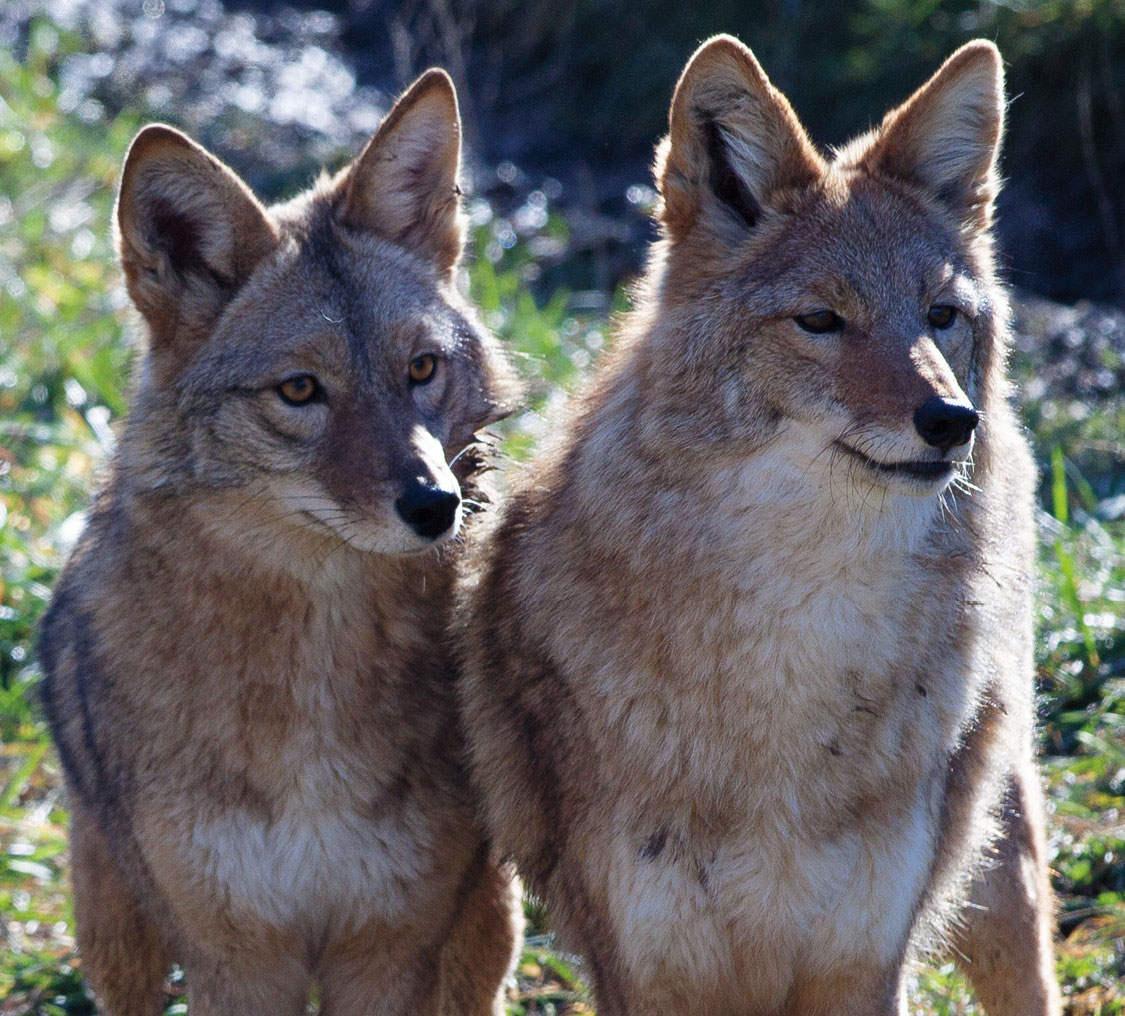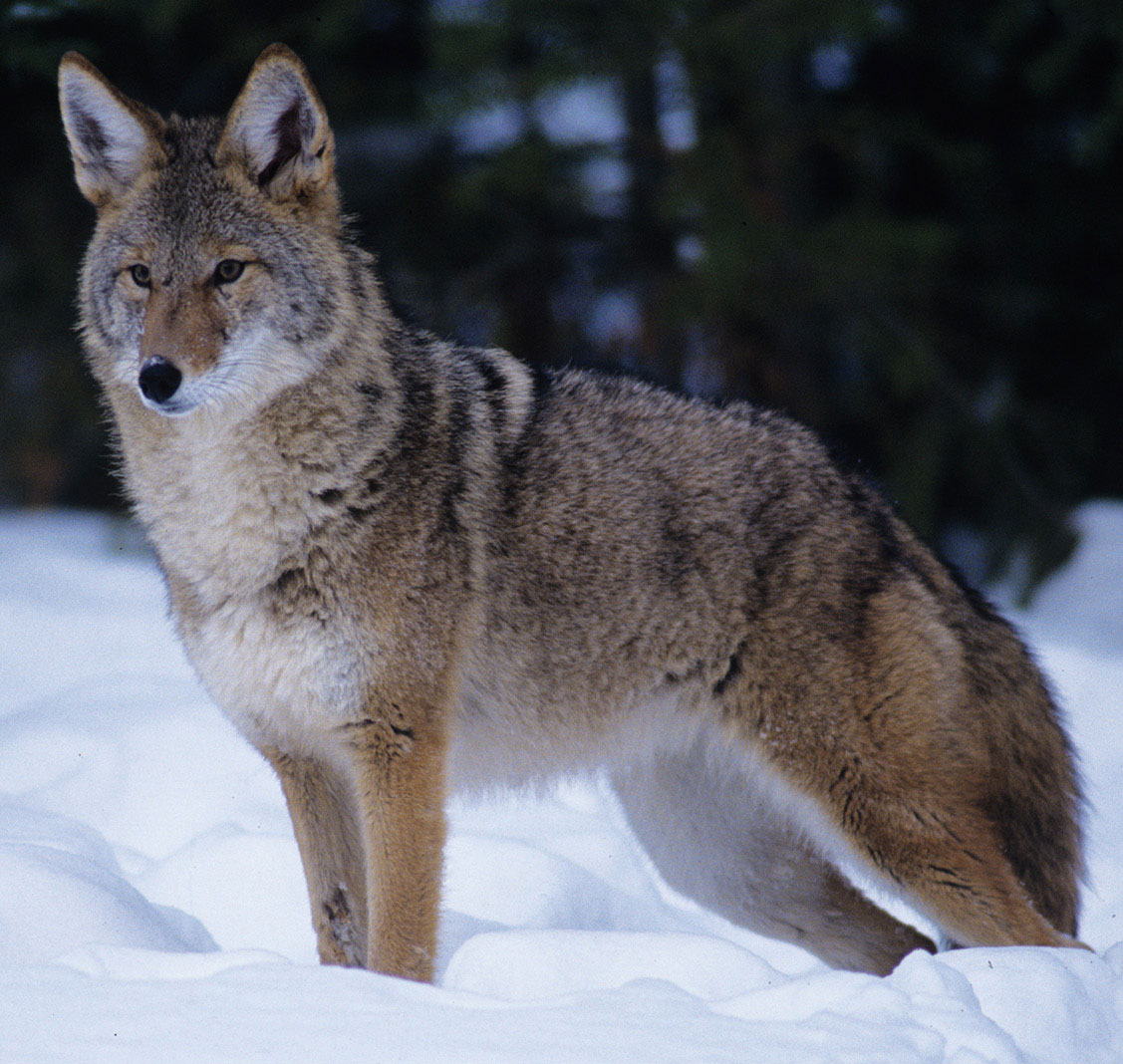Coyotes ‘Make a Go of It’ in Indiana
By Geriann Albers
 ODNR Division of Wildlife
ODNR Division of Wildlife
Indiana has many connections to the coyote. Coyote bones and skull fragments were unearthed at historic Native American sites like Angel Mounds and Anderson Mounds. Their pelts show up in old fur sale records as “brush wolves” or “prairie wolves”. County documents show bounty payments for coyotes in the late 1800s and early 1900s.
Even the American naturalist who gave the coyote its scientific name, Thomas Say, lived and is buried in New Harmony. The Canis latrans scientific name (meaning “barking dog”) for the coyote was earned and recorded by Say during an expedition he went on to explore the Missouri River with Major Stephen Harriman Long.
Early European settlers had negative views about predators like coyotes, and there were no wildlife laws or wildlife management at the time. Indiana, like many states and territories, enacted bounties on “wolves”, a term that then included coyotes, in 1799. These bounties, along with habitat changes that happened as many forests and prairies were turned into farms, eventually eliminated true wolves from Indiana.
The coyote remained, secretive and elusive. For the most part, they were found only in remnant prairie pockets, but they held on. Naturalist Walter Hahn talks about coyote populations increasing in his “Report of the State Geologist on the Mammals of Indiana” in 1909. But numbers still were not high, as the bounties, along with a lack of regulations and environmental changes kept coyotes cryptic and rarely seen through the early 1900s.
In the 1970s, coyote populations began to expand. With no competition from wolves, and people providing new food sources like fruit trees, coyotes adapted to new places and habitats, no longer limited to prairies. Now, coyotes are found in every nook and cranny of Indiana.
What does a day in the life of a coyote look like? In July, a coyote might wake up just as the sun is starting to set, stretch its legs and check on its gamboling pups that are just starting to have enough mobility to learn to hunt for themselves. Pups often start building hunting skills pursuing something easy, like an apple or a grasshopper.
Males and females stay together year-round, and the males help raise pups. But often the adults split off separately to look for food. Most often, they will try to hit a field edge in pursuit of mice, voles, or rabbits. They use their nose to follow trails, trying to find fresh scent. Then they use their hearing to zero in on slight movements before they will leap into the air to pounce on their prey.
While mice, voles, rabbits, squirrels, fruits, and nuts are their staple foods, coyotes will eat almost anything. They occasionally eat livestock and poultry, so owners must be thoughtful about husbandry practices, using things like secure fencing or guard dogs to protect their animals.
But not every coyote eats livestock. Some Western ranchers have learned that if they see coyotes on their property but are not having coyote issues, it is best to ignore them rather than killing them and risking new coyotes that might not ignore their livestock replacing them.
Coyotes also eat deer, primarily fawns. This is sometimes voiced as a concern by hunters as hurting the deer population. But Indiana is fortunate to have a healthy deer herd. Delaware, which has no coyotes or bobcats, has the same proportion of fawns die as Midwestern states like Indiana. With no wildlife predators in Delaware, the weakest or sickly fawns die of exposure, disease, and starvation. These are the fawns coyotes eat, the sick and weak, thus coyotes do not negatively affect Indiana deer populations. With Indiana leading in Boone and Crockett big-buck statistics for two years running, and the state’s hunters having harvested more than 100,000 deer since the 1990s, Indiana’s white-tailed deer populations have proven healthy and resilient to predation.
Coyote’s food choices also provide benefits, reducing mice populations near homes, crop fields, and grain storage. They have also been shown to keep urban goose populations in check in places where geese do not face hunting pressure. In urban areas, they raid nests for eggs and occasionally eat adults.
If successful at their hunt, coyotes will bring a portion of the food they catch back to their young, then head back out to hunt more. In July and into August, they may occasionally bring pups along on short hunts to start training them. If their hunt is not successful, they may keep at it through the daytime. Therefore, seeing a coyote during the day is not necessarily a cause for concern. Feeding hungry mouths is a lot of work for any species.
When rest time for coyotes arrives, they will search for a resting spot with cover. When their pups are young, coyotes use dens, typically hollow logs, culverts, enlarged abandoned groundhog dens, or something similar for cover. Once the pups get a little older and throughout winter, coyotes will rest in any type of dense cover that offers protection, such as thick grass, rock overhangs, or fallen logs.
In addition to hunting, training, and resting, coyotes may also do other things like grooming both themselves and their pups and inspecting their territory for intruders. Pups will also appear to play, but most of that is training for the future of being an adult coyote.
Young coyotes disperse from their parents to go find their own territories between 8–11 months old. They will wander for a while, trying to find unoccupied space. Eventually they will find somewhere with suitable food, water, shelter, and no other territorial coyote pair. In the process, they will often find a mate, though a rare coyote will stay solitary for longer. Those that do find a mate will start the cycle over, with daily hunting, keeping other coyotes away from their home range, and pups being born in spring.
I often get asked how many coyotes we have in the state. The short answer is we don’t know. Populations change daily as animals die and pups are born in spring. For animals like coyotes, we look at trends—or whether a population is increasing, decreasing, or staying the same—instead of trying to count them. We track coyote trends using the Archer’s Index, in which volunteer deer archery hunters tell us how many hours they were hunting and what wildlife they saw while sitting quietly in their tree stand. The index, which started in 1992, shows coyotes increasing until the 2010s, then dropping slightly and stabilizing in recent years. Coyote populations are stable and healthy in Indiana.
Coyotes have a natural fear of people. To date, we have not had a documented coyote attack on a person in Indiana. People can help keep it that way by thinking about doing their part to live safely with coyotes around. Make sure to keep garbage secure. Keep livestock and poultry penned when possible. Supervise pets when they are outside and keep them in a kennel with a secure top when they cannot be supervised. Coyotes see cats as food and dogs as a threat to their pups and intruders in their territory.
If you see a coyote around your yard and have concerns, think about what food sources may be attracting it. Take down bird feeders for a few weeks and move any outdoor pet food to a garage or shed. Pick up any fallen fruit from fruit trees. You can reinforce a coyote’s natural fear of people by shouting or making loud noises. Bang pots and pans, spray it with a hose, or toss small stones toward the coyote, but never corner it; always allow a clear path for it to escape.
We have coexisted with coyotes for a long time and will continue to do so. They are fascinating animals that can adjust to wherever they live. They eat persimmons when they live in the south and snowshoe hare when they live in the north. They adapt, just like people often do. I’m a native of Illinois, and I have lived in nine states on the course of my career journey. I ate barbecue when I lived in North Carolina, and I eat pork tenderloins and sugar cream pie now that I am in Indiana. I have been all over the U.S. and the one thing that has pretty much always been there too? Coyotes. That is why they are my favorite animal; I see a little of myself in their “make a go of it” spirit. ODNR Division of Wildlife
ODNR Division of Wildlife
It is the same spirit Thomas Say had, moving to Indiana to catalog the natural world and go on expeditions. And it’s the same spirit his wife, Lucy Way Sistare Say, had. A naturalist and illustrator, she was the first woman elected to the Academy of Sciences. Also a resident of New Harmony, she is just one of the Indiana women who blazed the trail for me to become Indiana’s furbearer biologist, writing about our native and adaptable coyote.
Geriann Albers is a furbearer biologist with the IDNR Division of Fish and Wildlife.
PHOTO CREDIT: ODNR Division of Wildlife
